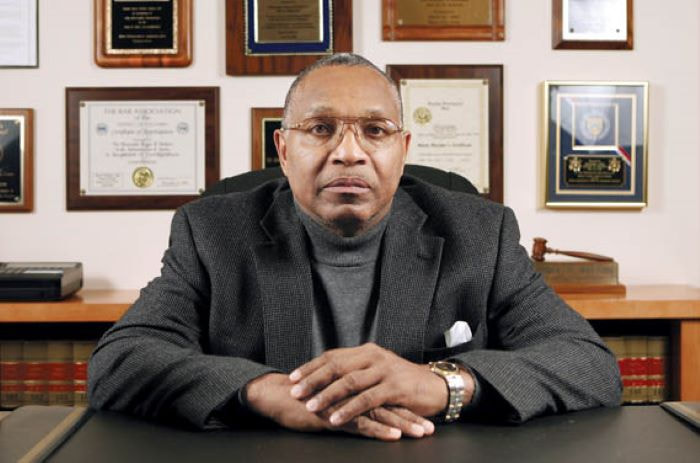|
On Thursday, a federal judge characterized the public statements of Attorney General William P. Barr as “distorted” and “misleading” in his early descriptions of Robert S. Mueller III's report last year. I missed the name of the judge at first, but later the name drifted from the television in the next room. “Oh, my God, that’s Reggie Walton!” I blurted, a bit informal toward a prominent judge. I learned about Federal Justice Reggie B. Walton a decade ago when I was writing a biography of Stan Musial, the great baseball player from Donora, Pa. I was blessed to have two mentor-guides to that hard-times steel town: Bimbo Cecconi, one of Pitt's great athletes, and Dr. Charles Stacey, the former school superintendent and a town historian who was proud of both Musial and Walton. “You ought to talk to Reggie Walton,” Dr. Stacey said. Later, on his own, he called his star pupil and suggested he give me a ring. That is the Donora connection – the pride of people who survived the mills and the streets and the hard times. There was a history to Judge Walton. His parents worked hard -- the job market was always tougher for African-Americans -- and had high hopes for their son. Reggie was a competitor, who goaded his football teammates not to quit against much bigger teams, but he also ran with a tough crowd. In his senior year of high school, he thought he was going to a fist fight between two gangs from opposite sides of the Monongahela River. Somebody pulled a sharp object and a boy from the other side was stabbed. Reggie Walton helped him get medical help, and then he decided to make himself scarce from gang activity. People in town pointed him toward West Virginia State University, a historically black college, to play football, and maybe to study. The football was all right, but the studying was better. Reggie Walton is now a federal district judge in Washington, D.C., who has been in the news a few times since being appointed by President George W. Bush. In 2005 the judge broke up a street brawl near the courthouse, and in 2007 he presided over the trial of I. Lewis (Scooter) Libby, for outing a C.I.A. agent. The jury convicted Libby and the judge sentenced him to 30 months, but President Bush set him free, and President Trump later pardoned Libby. The judge was reportedly not amused, either time. I finally got to meet Judge Walton in 2011 as he prepared for the perjury trial of Roger Clemens in the steroids frolics. Maybe because of his former school superintendent, Judge Walton agreed to meet me, on the grounds that we not discuss Clemens, at all. I thought maybe I could slip in a question or two, but after five minutes in his office, I knew better than to try to make a fancy journalistic feint through Judge Walton's defense. Nobody pulls the okey-doke on Judge Walton. I was in the courtroom in the first hour of the Clemens trial, when the prosecution alluded to a witness who had been ruled off limits. The highly-paid defense lawyer stuck up his hand and made an objection and the judge called a timeout, saying he needed a few minutes to think it over. After consulting his colleagues in back chambers, the judge declared a mistrial. This year Judge Walton was assigned a case questioning whether the attorney general had accurately portrayed the Mueller report long before the public could see it. The judge alluded to “inconsistencies” from the attorney general. In football terms, the liaison between the president and the attorney general has produced a dirty game for the past three years -- lots of grappling in the mud, kneeing and gouging in the pile. All I know is, when the oblong football skitters loose in a legal scrimmage, I want it to roll near Reggie Walton, from Donora, Pa. The article I wrote in 2011 before the brief Clemens trial:
https://www.nytimes.com/2011/03/03/sports/03vecsey.html Judge Walton's official website: https://www.dcd.uscourts.gov/content/senior-judge-reggie-b-walton
bruce
3/7/2020 02:26:08 am
george,
George Vecsey
3/7/2020 10:19:14 am
Bruce: I don't know the particulars of this ruling by Judge Walton -- there's always the Supreme Court -- but it's hard to erase days and days of headlines quoting this stern judge (appointed by GW Bush.)
bruce
3/7/2020 10:30:05 am
george,
Randolph
3/7/2020 09:15:35 am
George,
George Vecsey
3/7/2020 10:30:00 am
Randy, I did mention WV State for the judge. The link of my NYT column, included, mentions that that Judge Walton reached a plateau i football (his evaluation) but blossomed as a student and joined a fraternity that stressed academics...and eventually on to law school.
Ed Martin
3/8/2020 01:07:53 pm
Thanks GV, for the Reggie article, and for the wonderful additional comment on HB colleges and universities.
George
3/8/2020 03:36:58 pm
Ed: I’m sure it’s true — the chance to be oneself. 3/8/2020 02:02:56 pm
Thanks to George, Ed and Randolph for their first-hand accounts and Bruce's comments.
George
3/8/2020 03:43:09 pm
Alan: Jen wrote so well about the people who worked i your family store. One was an elder in an African family or region? Agreed about Clyburn and would add Elijah Cummings:, “We’re better than that!” We need that prophetic voice calling to our better selves, or what is left of that. GV Comments are closed.
|
Categories
All
|










